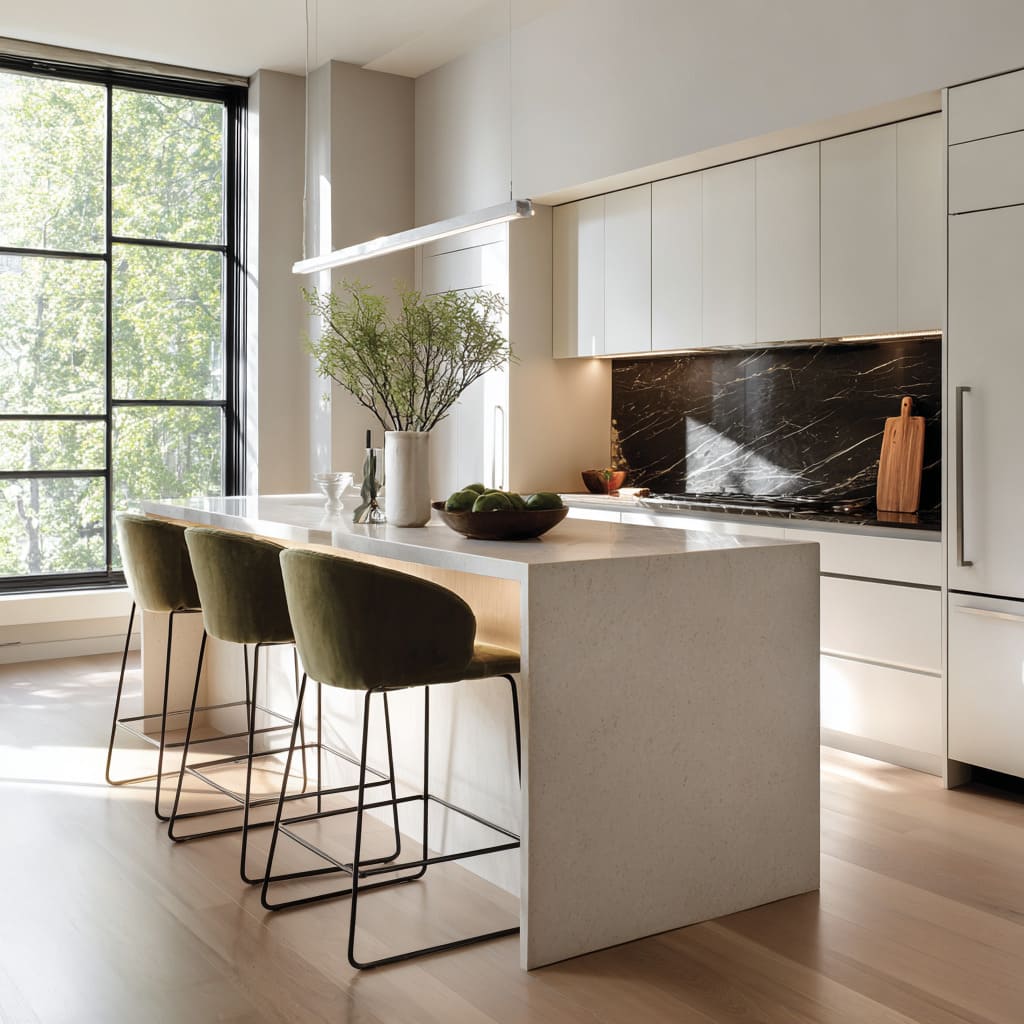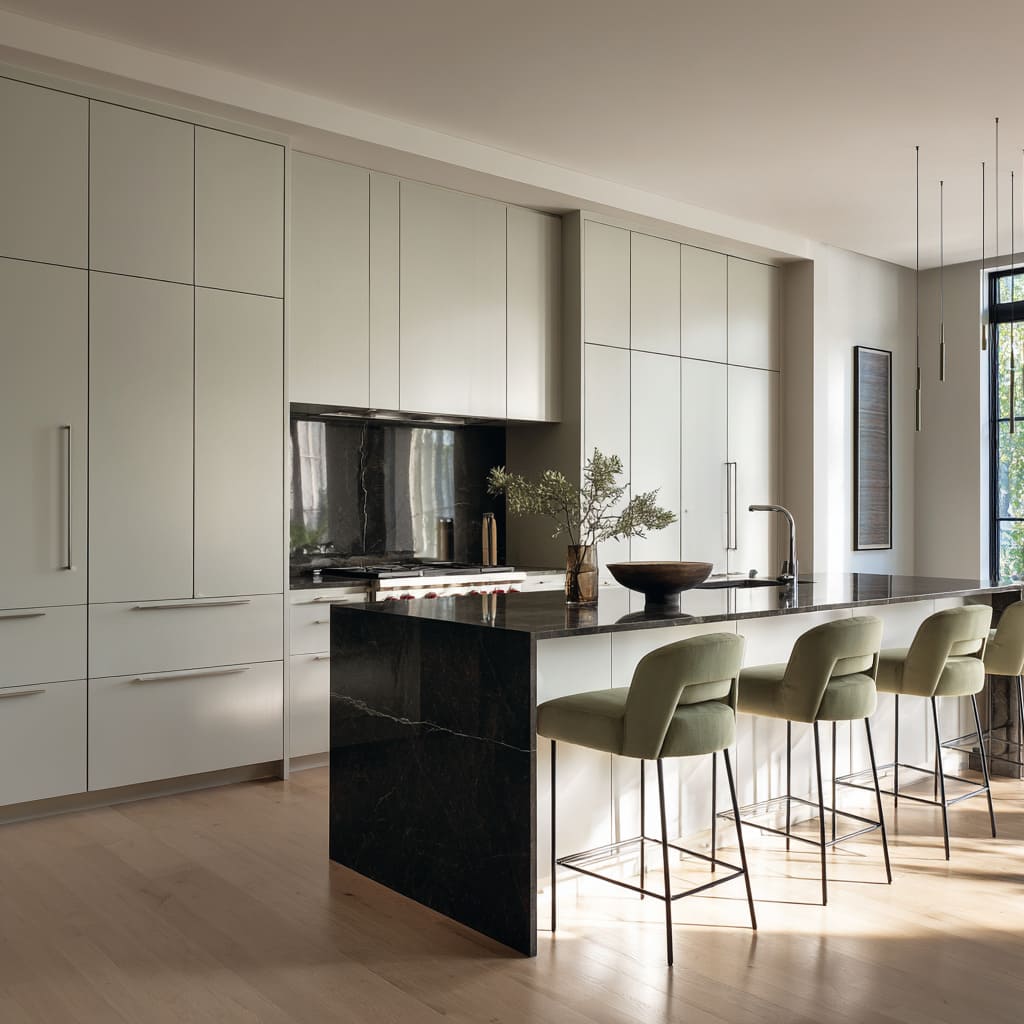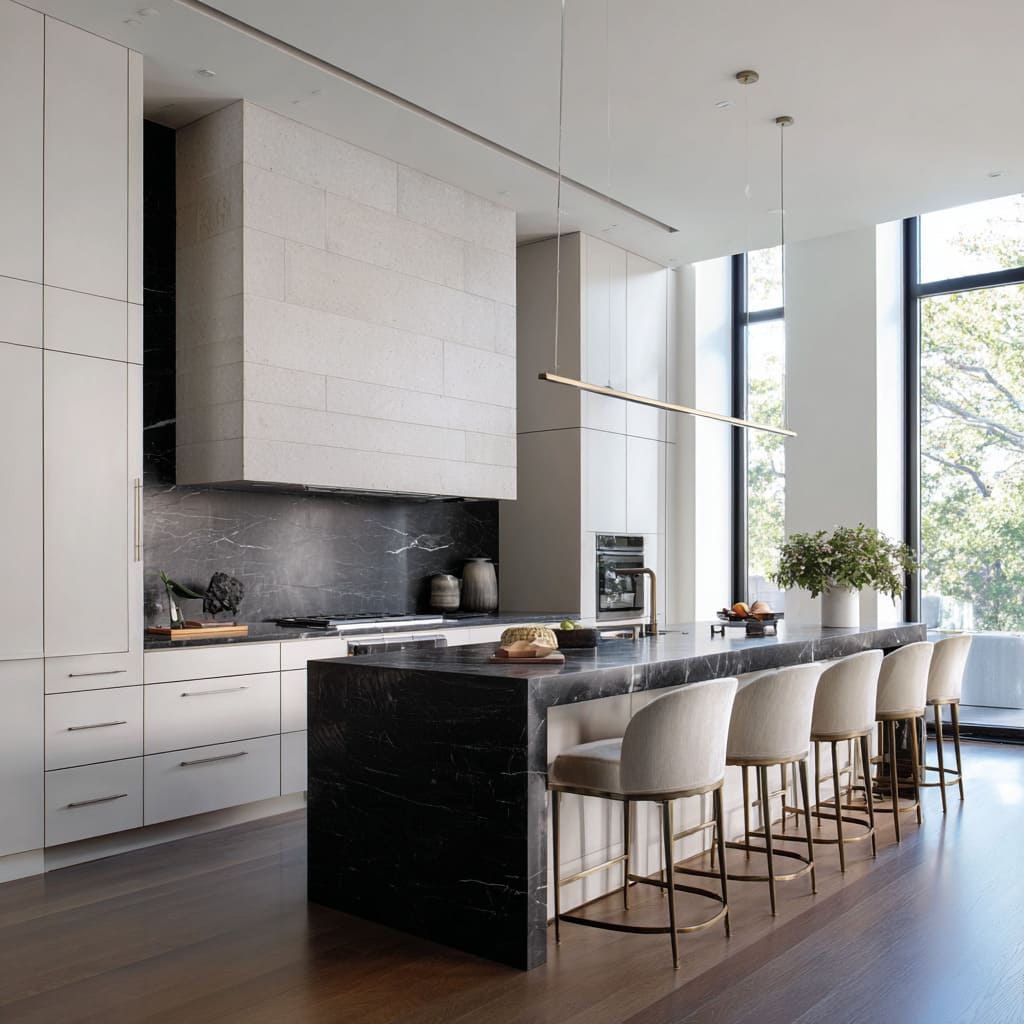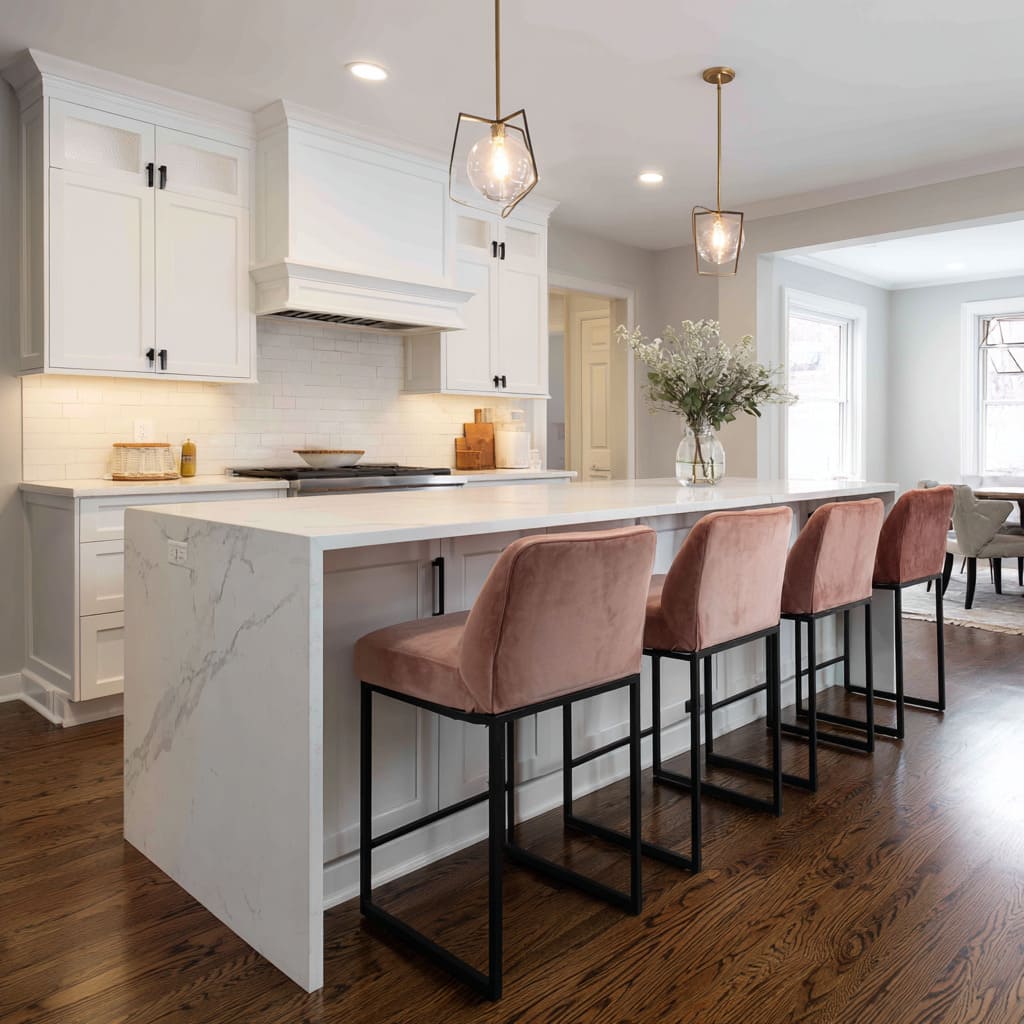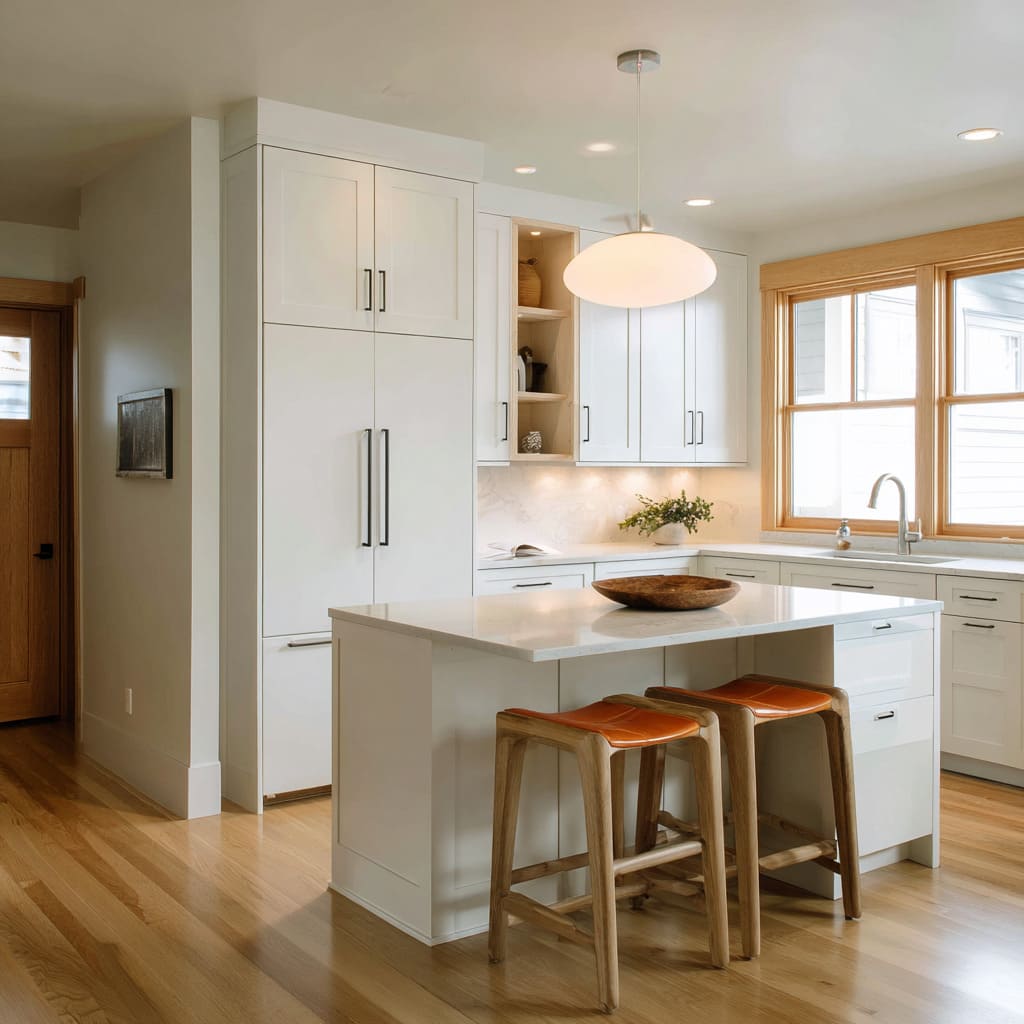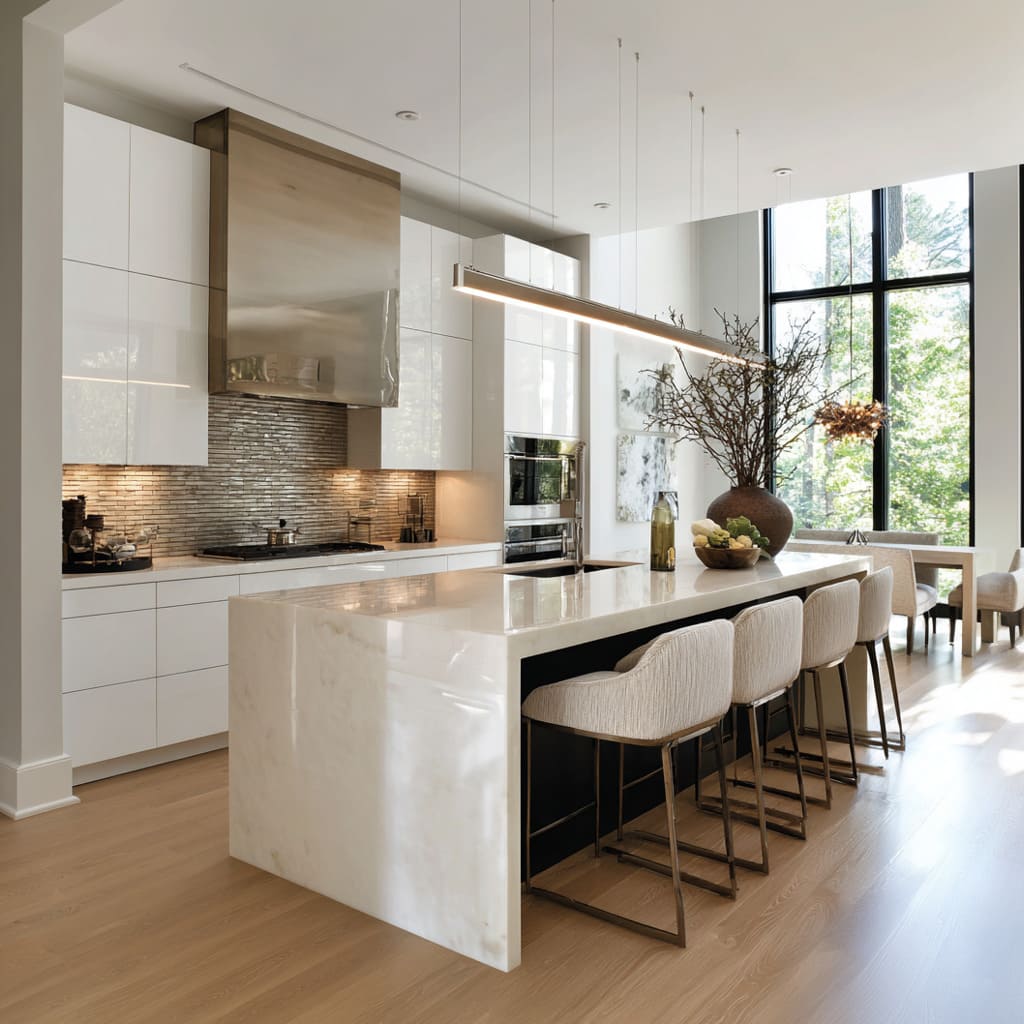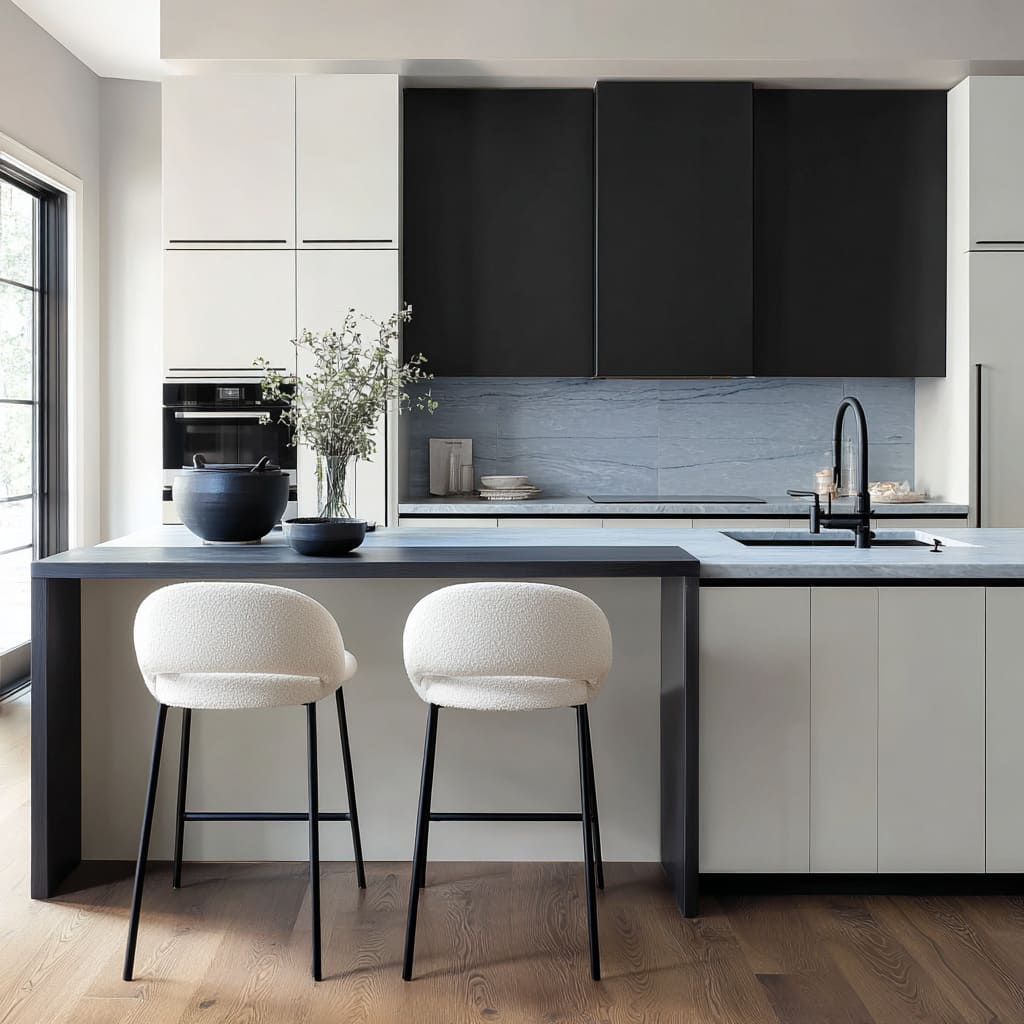Modern white kitchens often appear calm at first glance, but the seating choices beneath the island reveal a deeper design system that shapes rhythm, temperature, and visual structure. When the palette is pared back to pale stone, sleek cabinetry, and soft natural light, the stools become the elements that carry color nuance, curvature, softness, and subtle texture.
Their shapes guide the mood of the island, their fabrics affect the way light travels, and their lines help organize the composition. In many contemporary interiors, this means that the search for bar stool ideas for white kitchen settings begins not with color, but with how the stool collaborates with the architecture surrounding it.
The designs explored here reveal how modern interiors use seating as a form of silent structure—balancing warm wood, cool stone, and dark accent lines through shape, tone, and light behavior.
Color as a Temperature Tool in All-White Interiors
Color remains one of the most discreet tools in a pale kitchen, and modern stools often carry the only controlled dose of hue within the space. Soft sky-blue upholstery introduces a delicate cool note that clears the whiteness without hardening it; muted olive and sage threads weave warmth into stone or black accents; and pale sand or blush velvet brings a softened warmth to even the crispest quartz.
These are not statement tones. They sit in quiet mid-range values that bridge gaps between dark countertops, pale floors, and light cabinetry.
In many contemporary designs, the hues serve as a tonal hinge between extreme contrasts. A deep, glossy waterfall in black stone meets white cabinetry, and in between them sage or pistachio fabric provides a low-saturation mediator.
Velvet in gentle rose or oatmeal allows a white stone island to feel more relaxed and grounded. In some rooms, the stools carry colors that shift with the light—cool under morning shadows, warmer by afternoon—so each stool behaves like a small chroma instrument that subtly softens the visual transitions within a room.
Muted Upholstery as a Connector Between Stone, Wood, and Metal
A recurring move in modern kitchen designs is the use of fabric that bridges neighboring materials. When a room mixes warm oak floors with cool stone slabs, leather or woven seats in graphite tones create equilibrium.
When pale timber paneling meets a crisp white top, grounded olive fabrics connect both sides through shared undertones. Such fabrics do not compete with stone veining or cabinetry grids; instead, they operate as a median between cold and warm elements.
Three frequent bridging strategies appear in these concepts
- Mid-value upholstery: Colors that sit halfway between stone and wood tone become a gentle mediator.
- Gray-green tones: Soft olive or sage links pale oak, veined stone, and matte black accents.
- Soft pastels: Powdery blues or sand-pink velvets clean the palette without introducing vivid saturation.
This approach keeps the island unified with the surrounding materials. The stools do not disrupt the palette; they shape its transitions.
Texture
Texture is one of the most sophisticated forces at work in the modern white kitchen. Because white surfaces reflect broadly and can flatten visual depth, the fabric on the stools often becomes the place where designers bring micro-shadow, grain, and softened highlights.
Boucle scatters light through tiny loops, velvet shifts in tone as it curves, and ribbed textile throws faint vertical shadows that introduce dimensionality without patterns. Leather adds gentle highlights that echo metal hardware.
Smooth graphite leather may reflect only a small line of pendant light, but that line ties the seat to brushed metal bowls or the subtle shine of faucet arcs. Woven fabrics contribute speckled depth close up while remaining visually quiet from afar.
Such textures turn each stool into a small instrument that keeps the kitchen from becoming visually flat or glossy.
Back Heights, Rails, and Shadow Alignments
Line discipline underpins most of the modern examples seen in these concepts. The height of the stool back, the alignment of the foot bar, the rhythm of slender legs—each of these details engages with the architecture of the island and the cabinetry behind it.
Many stool ideas carry backs that land just under the stone top, creating a soft underline rather than a row of protruding peaks. This maintains the island as a continuous band from afar.
Foot bars often align perfectly across multiple stools, forming a subtle horizontal band that echoes toe-kick shadows, countertop reveals, or pendant heights. Thin black frames often draw parallel lines with window mullions or cabinet seams, reinforcing the room’s graphic order.
The interaction between vertical legs and long horizontal counters produces a soft architectural cadence. The stools become the link between the island’s heavy slab and the floating lines above it.
Shape and Silhouette: Curves, Saddles, Boxes, and Shells
The silhouette of each stool shifts the role of the island. Rounded bucket seats with small wings promote longer seating moments; backless saddles maintain a minimal footprint; rectilinear forms underline the kitchen’s crisp geometry; and compact shells give a quiet fullness that works under a strong waterfall.
Common seating families identified in these concepts:
Silhouette choices define how the island is read—from a minimal sculpture to a social gathering point.
The Relationship Between Stool and Island: Inner Faces, Inset Shadows, and Waterfalls
The vertical surface behind the stools—the inner face of the island—is one of the most influential but overlooked surfaces in a white kitchen. In some designs, it is painted black so that dark stools vanish into the void, giving the island the look of a clean monolith.
In others, the inner surface is made of pale timber, backlighting velvet cushions during daytime and creating a warm halo around the seating. When stools carry slender sled bases, the oak flooring continues visually beneath them, maintaining spatial openness.
When stools rest under a dramatic black waterfall, muted fabric softens the contrast, ensuring that the island remains powerful but not severe. The island’s vertical band becomes a stage against which the seating either blends or glows, depending on color and texture.
Spacing and Rhythm
A single sculpted seat creates an intimate moment at the end of an island, functioning almost like a lounge chair in a compact setting. This produces a gentle emphasis on that corner of the kitchen, adding a personal moment within a clean, modern envelope.
In contrast, a four- or five-seat arrangement becomes a rhythmic band. The island then reads as a central social area with visual repetition anchoring the room.
List forms help clarify these two approaches:.
Single seat roles
- Acts as a soft counterpoint to a linear island
- Creates a focused spot that signals relaxation
- Allows stronger textures like boucle or plush fabrics
Row seating roles
- Establishes a steady horizontal pattern
- Partners with long pendants to create matched intervals
- Makes the island appear more expansive and balanced
Spacing remains intentionally generous. Each stool holds enough space around it to remain legible, contributing to rhythm while avoiding crowding.
Metal Accents as the Linking Thread of the Kitchen
Metal frames on the stools often unify the room’s palette. Thin black frames echo trims around windows, toe-kicks, and faucets.
Brushed brass foot rails pair gently with warm stone veining, pendant hardware, or subtle brass on hood trim. Bronze sled bases introduce a warm undertone that matches stainless surfaces or metallic mosaics nearby.
The metals never dominate; their finish tends to be brushed or aged, offering glow rather than shine. This keeps the visual language coherent and soft.
These frames behave like connecting strokes between islands, lighting, cabinet handles, and even sculptural accessories placed on the counter.
The Visual Mood of the Island Defined by Seating
The island may be the physical centerpiece, but the stools shape its emotional tone. Whether the aim is calm hospitality, structured modernity, coastal freshness, or soft contemporary warmth, the seat forms and fabrics direct that mood.
When the island is dark and dramatic, pale upholstery and slim metal frames lighten the lower third of the room. When the island is white and minimal, earthy or textured fabrics keep it from feeling cold.
Even in very bright interiors with expansive windows, the stools hold their own presence. Muted olive takes on golden undertones at sunset; pale blue cleanses the white cabinetry under cool skylight; and sand-colored ribbed fabrics mirror the gentle verticality of tall pantry doors.
This interplay reveals how, in modern environments, white kitchen island stools often act as the main expressive element within a restrained composition.
Material Harmony: Wood Bases, Velvet Crowns, Leather Seats
Wood bases in pale oak ground the seating in natural warmth. Velvet cushions crown the stools with soft visual weight.
Graphite leather provides a balanced sheen that aligns with soap pumps, glass vessels, or brushed-matte faucets nearby. Boucle seats add softness that gently contrasts the straight-edged cabinetry.
Each material influences how the island feels: light, structured, airy, or inviting.
Notable material patterns present in the concepts
- Velvet with warm undertones balancing black stone
- Leather matching dark insets for a seamless appearance
- Oak frames with pastel cushions creating a soft coastal touch
- Ribbed upholstery adding vertical movement to a linear kitchen
- Boucle textures softening hard edges and catching warm light
Through these combinations, stools unify multiple tactile elements, giving the kitchen a balanced and cohesive tactile presence.
How Seating Shapes the Compositional Balance of a White Kitchen
Because white cabinetry and stone surfaces often create broad, uninterrupted planes, the stools supply the finer relational details. Their spacing informs the flow of the room.
Their tone shifts the weight distribution between floor and counter. Their texture adjusts light absorption at the base of the island.
When they carry slender frames, the island appears more delicate; when they carry heavier silhouettes, the island reads as grounded and substantial. In quiet interiors inspired by general European modernism or by clean-lined suburban environments, the stools become the meeting point between large architecture and human scale.
Their shapes respond to the island’s geometry while adding comfort, color, and volume in a subtle, controlled manner. This layered approach demonstrates how white kitchen bar stool ideas extend far beyond selecting a seat.
They involve tuning the interplay of light, surfaces, and silhouettes within the wider kitchen composition.
The Subtle Presence of Neutral Tones and How They Anchor Modern Design
Neutral tones within the stools—ranging from smoky graphite to pale sand—act as anchors that guide visual movement. Smoky leather holds its place between pale cabinetry and warm flooring.
Oatmeal upholstery brings softness to tall windows and strong stone backsplashes. Powdery blue on square cushions reflects skylight and helps unify light oak, white lacquer, and brass pulls.
These colors form a quiet fabric that stabilizes the palette. When placed against dark waterfall slabs, neutral seating adds softness.
When used with pale tops, warm or muted hues prevent the kitchen from becoming glassy or sterile. Through these restrained tones, the room carries both visual comfort and compositional clarity.
This approach exemplifies refined white kitchen stool ideas where subtle shifts in warmth and value deliver the emotional tone of the space.
Seating as a Link Between Floor, Countertop, and Cabinetry
In many of the concepts described, the stools sit at the exact midpoint of the vertical section between floor and countertop. Their materials often echo both ends of this section.
Wood legs pick up the grain of flooring, while fabric colors respond to the veining in the countertop. Metal rails join hardware on drawers and pendants above.
In white kitchen desigs with long, monolithic islands, this mid-level band of stools becomes a critical visual link between the horizontal surfaces. Without it, the room would split into upper and lower halves.
With the stools, the island reads as a layered, considered composition where each band supports the one above and below. This is especially important in large spaces with dramatic stone, sculptural range hoods, or tall windows.
Through these connective roles, stools serve as quiet bridges, making them a cornerstone in articulate white kitchen island stools arrangements.
Soft Curves and Clean Edges: The Balance That Defines Modern Interiors
Modern white kitchens can adopt a dialogue between curves and straight lines. Curved stool backs soften strong vertical cabinet grids.
Bucket seats ease the strict posture of flush cabinetry. Straight metal sleds reinforce the clarity of toe-kick trims and floating slabs.
Rounded saddle seats complement radius corners on countertops or gently curved pendant silhouettes. This balance of curve and line keeps a white kitchen from feeling clinical.
It introduces human scale while respecting the clean geometry of modern architecture. In many interiors across contemporary homes, these curves appear subtly—nothing oversized, nothing theatrical.
The stools assume the role of soft counterpoint to the crispness above them, shaping the room’s character through their silhouette.
Closing Reflection
The understated presence of modern stools in white kitchens reveals an intricate design logic. Their muted colors merge materials; their textures form gradients of shadow; their shapes guide the tone of the island; their spacing establishes rhythm; and their metal lines quietly echo the architecture.
They sit at the intersection of comfort, color, silhouette, and light. These concepts demonstrate how, in many contemporary interiors, seating acts as the medium through which a white kitchen gains depth, warmth, structure, and expression.
Through these layers—subtle, deliberate, and multidimensional—the modern island becomes more than a surface; it becomes a soft threshold between architecture and daily life, shaped most beautifully by the chairs placed beneath it.

